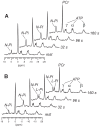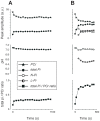Work-related pain in extrinsic finger extensor musculature of instrumentalists is associated with intracellular pH compartmentation during exercise
- PMID: 20161738
- PMCID: PMC2817730
- DOI: 10.1371/journal.pone.0009091
Work-related pain in extrinsic finger extensor musculature of instrumentalists is associated with intracellular pH compartmentation during exercise
Abstract
Background: Although non-specific pain in the upper limb muscles of workers engaged in mild repetitive tasks is a common occupational health problem, much is unknown about the associated structural and biochemical changes. In this study, we compared the muscle energy metabolism of the extrinsic finger extensor musculature in instrumentalists suffering from work-related pain with that of healthy control instrumentalists using non-invasive phosphorus magnetic resonance spectroscopy ((31)P-MRS). We hypothesize that the affected muscles will show alterations related with an impaired energy metabolism.
Methodology/principal findings: We studied 19 volunteer instrumentalists (11 subjects with work-related pain affecting the extrinsic finger extensor musculature and 8 healthy controls). We used (31)P-MRS to find deviations from the expected metabolic response to exercise in phosphocreatine (PCr), inorganic phosphate (Pi), Pi/PCr ratio and intracellular pH kinetics. We observed a reduced finger extensor exercise tolerance in instrumentalists with myalgia, an intracellular pH compartmentation in the form of neutral and acid compartments, as detected by Pi peak splitting in (31)P-MRS spectra, predominantly in myalgic muscles, and a strong association of this pattern with the condition.
Conclusions/significance: Work-related pain in the finger extrinsic extensor muscles is associated with intracellular pH compartmentation during exercise, non-invasively detectable by (31)P-MRS and consistent with the simultaneous energy production by oxidative metabolism and glycolysis. We speculate that a deficit in energy production by oxidative pathways may exist in the affected muscles. Two possible explanations for this would be the partial and/or local reduction of blood supply and the reduction of the muscle oxidative capacity itself.
Conflict of interest statement
Figures


References
-
- Sluiter JK, Rest KM, Frings-Dresen MH. Criteria document for evaluating the work-relatedness of upper-extremity musculoskeletal disorders. Scand J Work Environ Health. 2001;27(Suppl 1):1–102. - PubMed
-
- Fry HJH. Overuse syndrome of the upper limb in musicians. Med J Aust. 1986;144:182–183. - PubMed
-
- Stone WE. Repetitive strain injuries. Med J Aust. 1983;2:616–618. - PubMed
-
- Winspur I. Controversies surrounding “misuse,” “overuse,” and “repetition” in musicians. Hand Clin. 2003;19:325–329. - PubMed
-
- Fry HJH. Incidence of overuse syndrome in the symphony orchestra. Med Probl Perform Art. 1986;1:51–55.
Publication types
MeSH terms
Substances
LinkOut - more resources
Full Text Sources
Medical
Research Materials
Miscellaneous

